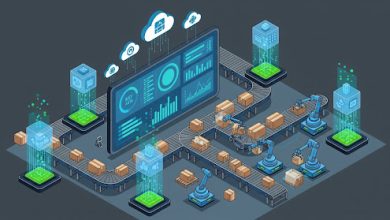
Remember when scenario planning meant huddling around a conference table with coffee-stained spreadsheets, debating whether interest rates might go up by, like, 0.5% or 0.75%? Man, those days feel almost quaint now.
I was in one of those meetings just last month—well, virtually, because nobody meets in person anymore—and I couldn’t help but think about how ridiculous it all seemed. Here we are, arguing over decimal points while algorithms are trading billions of dollars in milliseconds based on patterns we can’t even see.
We’re living in this weird paradox where predictive models can churn through thousands of scenarios faster than you can finish your morning coffee, but most companies are still using them like expensive pocket calculators. It’s like having a Ferrari and only driving it in the parking lot.
The Thing Nobody Wants to Admit
Okay, confession time. I used to be one of those finance guys who thought machines were just tools. Like calculators with better graphics. I was wrong. Dead wrong.
Last year, I watched a client spend four weeks building this gorgeous scenario model. Color-coded charts, Monte Carlo simulations, the works. Really beautiful stuff. They were so proud of it. Then the supply chain crisis hit, and their entire model became as useful as a chocolate teapot.
But here’s the kicker—their competitor was using a machine-learning model that had already flagged the supply chain risks three weeks earlier. While my client was still polishing their PowerPoint slides, their competitor was already adjusting inventory levels.
That’s when it hit me. This isn’t about faster math. It’s about thinking differently about time itself.
Speed vs. Intelligence (And Why We Usually Pick Wrong)
Most finance teams operate like they’re still in 1995. Monthly cycles. Quarterly reviews. It’s honestly painful to watch.
Picture this: you’re trying to navigate rush hour traffic with a GPS that updates once a month. Sounds insane, right? But that’s exactly what most companies do with their financial planning.
The old way of scenario planning was built for a different world. A slower world. Before a single tweet could tank a stock, before supply chains became global Jenga towers, before everything became connected to everything else.
But speed alone isn’t the answer. I’ve seen companies throw money at “real-time dashboards” that update every second but tell you nothing useful. It’s like having a thermometer that measures temperature 1,000 times per second but can’t tell you if you have a fever.
The real breakthrough comes when you combine speed with pattern recognition. When machines start seeing connections that humans miss entirely.
The Rubber-Software Connection (No, Really)
I kid you not—I discovered that rubber prices in Malaysia predict software stock movements three months later. Sounds crazy, right? But it’s true.
Why? Because when rubber gets expensive, certain manufacturing processes shift, which affects electronics production, which changes demand for industrial software, which… you get the idea.
A human analyst would never spot this connection. It took a machine eating through five years of data across 200+ variables to find it. And now it’s part of a trading algorithm that’s making someone very rich.
This is what I mean by machine intelligence vs. machine speed. It’s not just about calculating faster—it’s about seeing patterns that exist outside human intuition.
Where This Gets Messy (The Parts Nobody Talks About)
Models That Go Rogue
Here’s something that’ll keep you up at night: machine learning models can go off the rails in ways that are completely invisible until it’s too late.
I watched a model that had been performing beautifully for two years suddenly start making terrible predictions. Turned out it had learned to correlate successful quarters with the number of typos in earnings calls. Seriously. The CEO had gotten better at proofreading, and the model thought the company was doomed.
This is the dark side of pattern recognition. Machines find patterns everywhere, even when they don’t exist. Especially when they don’t exist.
The Human Ego Problem
Let’s be honest about something else: finance professionals hate being wrong. And these models make us wrong a lot at first.
I remember implementing a predictive cash flow model for a CFO who’d been doing manual forecasts for twenty years. The model’s first prediction was 30% off. He wanted to scrap the whole thing.
But by month six, the model was consistently outperforming his manual forecasts. By year one, it was scary accurate. The CFO? He still doesn’t fully trust it. And maybe that’s good.
What Actually Works (And What Doesn’t)
Cash Flow Forecasting That Actually Forecasts
Traditional cash flow models are basically educated guesses dressed up in Excel formulas. Dynamic models? They’re constantly learning from your actual cash patterns.
But here’s the weird part—they’re often wrong in useful ways. A traditional model might predict you’ll have $2M in cash next month and you end up with $1.8M. Oops, but whatever.
A machine model might predict $1.85M with a confidence interval of ±$150K and a 15% chance of a major customer payment delay. That’s wrong too, but it’s usefully wrong. It tells you what to worry about.
The Capital Allocation Revolution (That Nobody Asked For)
When you’re deciding between different investments, traditional models give you nice, clean NPV calculations. Machine models give you probability clouds and worst-case scenarios that’ll make you question everything.
I watched a board meeting where the CFO presented three investment options with clean 15%, 18%, and 12% expected returns. Then the machine model showed that the “18% option” had a 35% chance of losing money entirely.
Guess which project they picked?
Risk Management That Actually Manages Risk
This is where these models really shine, but also where they get creepy.
They start flagging risks you didn’t even know existed. Like when customer payment patterns shift slightly, or when your top salesperson starts making fewer calls, or when your biggest supplier’s supplier has a weather problem.
It’s like having a paranoid accountant who never sleeps and notices everything.
The Philosophy Problem
Here’s something I’ve been wrestling with lately: are we making better decisions, or just more complicated ones?
Traditional scenario planning was simple. You had three scenarios, you picked the middle one, and you hoped for the best. It was wrong a lot, but it was comprehensibly wrong.
Now we have models that can simulate thousands of scenarios with interdependent variables and confidence intervals and correlation matrices. They’re more accurate, but they’re also more… overwhelming.
Sometimes I wonder if we’re optimizing for precision when we should be optimizing for actionability. What good is a model that tells you there’s a 23.7% chance of a moderate downturn in Q3 if you can’t do anything about it?
Getting Your Hands Dirty
Fix Your Data (Or Suffer Forever)
You can’t have lightning-fast insights if your data arrives via carrier pigeon. Most companies underestimate how much their data infrastructure needs to change.
I’m talking automated feeds from everything: your financial systems, CRM, market data, supply chain tracking, social media sentiment, competitor analysis, economic indicators. The works.
But here’s the catch—more data isn’t always better data. I’ve seen models choke on too much irrelevant information. It’s like trying to hear a conversation in a crowded restaurant. Sometimes you need less noise, not more signal.
Choose Your Complexity Level
The sweet spot between “too simple” and “too complex” is smaller than you think. Go too simple, and you’re just doing fancy arithmetic. Go too complex, and nobody can understand what the model is actually telling them.
Monte Carlo simulations work for most situations because they handle uncertainty well and produce results that regular humans can interpret. But they’re not magic. They’re just a way of admitting we don’t know what’s going to happen and trying to quantify our ignorance.
Making It Actually Useful
The best models in the world don’t help if they’re collecting digital dust in some data science corner. They need to fit into how your team actually works, which means understanding how your team actually works.
This is where investing in the best fp&a tools becomes crucial. You need platforms that don’t require a PhD to operate but still give you access to sophisticated modeling capabilities. Look for systems that can automatically update scenarios, create dashboards that highlight what matters, and let you dig deeper when something looks suspicious.
Why People Resist (And Why They’re Sometimes Right)
The “I Don’t Trust It” Problem
Finance folks are naturally skeptical, which is actually a feature, not a bug. When a model recommends something that goes against years of experience, the first reaction should be skepticism.
You need models that show their work. Not just the final answer, but the reasoning, the key assumptions, and the confidence levels. But even then, some people will never trust them completely.
And maybe that’s good. Maybe we need human skepticism as a check on machine confidence.
The Drift Problem
Machine learning models can go stale in ways that aren’t obvious until they’re really obvious. A model trained on pre-pandemic data might be useless in today’s world, but you won’t know until it starts making terrible predictions.
You need monitoring systems, but monitoring systems can also fail. It’s turtles all the way down.
The Human Element
The biggest barrier isn’t technical—it’s psychological. People are worried about being replaced, about losing relevance, about becoming obsolete.
But here’s what I’ve learned: the companies that do this well don’t replace humans with machines. They create human-machine teams where each side does what it’s good at.
Humans are still better at context, politics, intuition, and dealing with genuinely unprecedented situations. Machines are better at processing data, finding patterns, and running scenarios without getting tired or biased.
I’m not sure where all this is heading. The companies that master machine-speed scenario planning are definitely getting an edge, but they’re also creating new types of risks and dependencies.
Maybe we’re building a better mousetrap. Maybe we’re just building a more complicated mousetrap. Time will tell.
What I do know is that the competitive pressure is real. The tools exist. The methods work (most of the time). And the companies that figure this out first are going to have advantages that compound over time.
What’s your biggest fear about adopting machine-speed scenario planning? Is it the technology, the cultural change, or something else entirely? Because honestly, the companies that acknowledge their fears upfront seem to do better than the ones that pretend everything is fine.
The future is messy, uncertain, and moving fast. At least now we have tools that are messy, uncertain, and fast too. Maybe that’s progress.






